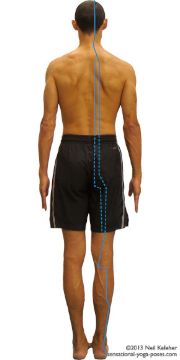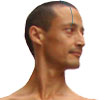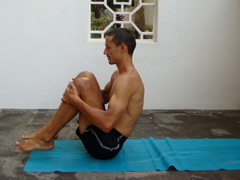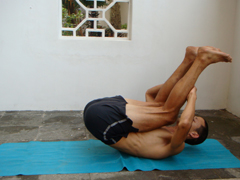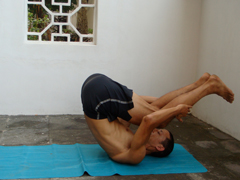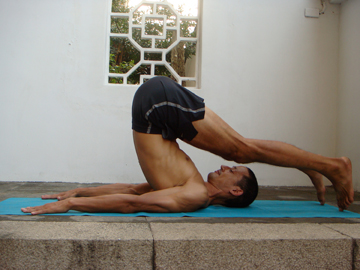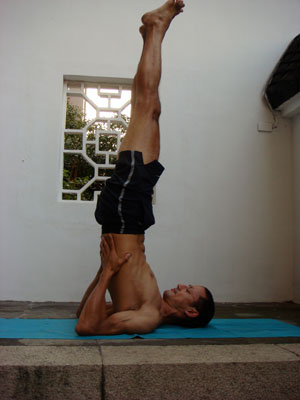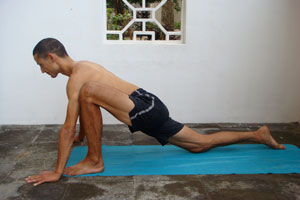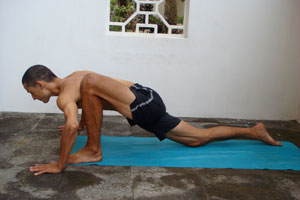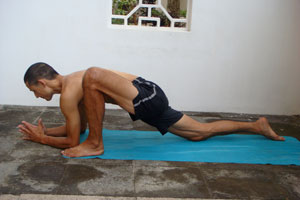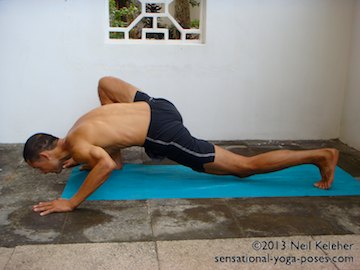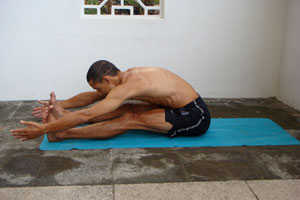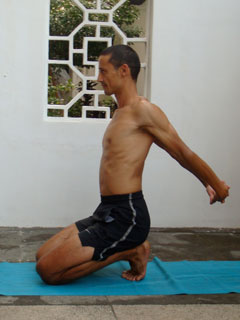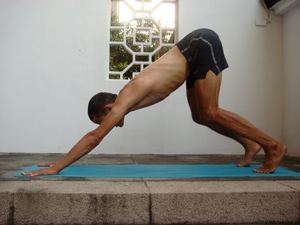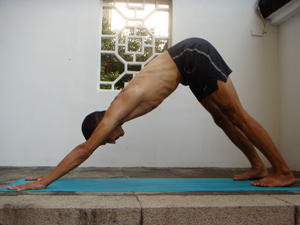Bladder Meridian Stretches
Meridian stretches for the back of the spine, hips, knees and ankles
The following meridian stretches are for bladder meridians which runs down the back of the body.
It starts at the forehead, runs overs the top and down the back of the head and back of the neck. It runs alongside the spine in two lines on each side of the body (4 lines in total.) These two lines merge above the knee to continue down the back of the calf and along the outside edge of the feet.
To stretch the bladder meridian at the back of the neck you can bend your neck forwards.
You can stretch it down the length of your spine by bending your spine forwards. You can stretch the it at the back of the hip by doing a forward bend and you can extend that stretch to affect the back of the thighs and knees by bending forward with your knees straight.
You can also stretch it by stretching the calf and the back of the ankle.
Since this meridian originates above the eyebrows it may be affected by lifting your eyebrows.
Mr Spock anyone?
Bladder Meridian Stretches for the Back of the Neck and Spine
Bladder meridian stretches include stretching the back of the neck. The simplest way to stretch the back of the neck is to bend the neck forwards. You can do this while sitting and with your chest lifted and your ribs expanded. Lengthen your neck and allow your head to sink down.
Another option is to do the yoga poses called plough and shoulderstand. Prior to doing these meridian stretches you can practice rolling back and forwards.
Rolling Back and Forwards
To roll back and forwards you have to round your spine. In so doing you stretch the bladder meridian and the back of your spine. Just as importantly, if you aren't used to doing shoulderstand or plough pose you can use this as an opportunity to practice feeling the relatinoship between your center and your foundation... in other words you can practice balancing. When you roll forwards balance on your sitting bones.
When you roll back try to get your weight over your shoulders and keep it there. Once you can balance in these two positons work at controlling the rate at which your roll back and forwards. See how slowly you can roll in both directions.
Plough Pose (Halasana)
In plough pose you lay down on your back and touch your toes to the floor behind your head.
To get into this yoga pose lay down with your hands beside you. Press your arms down into the floor, lift your pelvis and reach your legs back. Try to find a similiar feeling to when you were rolling backwards. Go slowly. As you lift your pelvis and reach your legs back round the lower half of your spine. As you lift your pelvis higher bend the upper part of your spine. If the back part of your upper cage is particularly tight, you might want to use your hands to support your thighs and focus on relaxing the back of your upper spine. Gradually move deeper. And if it feels too uncomfortable stop.
You may find it easier to relax your upper back once you get your feet to the floor. If your feet can't reach the floor then try resting them on a chair.
If your feet are on the floor, you can bend your spine forwards further by moving your feet away from your head while keeping your toes on the floor.
To lift your spine off of the floor, particularly your C7 vertebrae, move your shoulder blades towards each other. To do this grab your hands or grab the sides of your mat and squeeze your arms together. As you move your shoulder blades towards each other notice how this causes your upper ribcage and the base of your neck to move away from the floor.
Shoulderstand (Sarvangasana)
Shoulderstand is similar to plough pose however, your legs reach straight up. Where in plough pose you can bend most of your spine forwards, in shoulderstand the bend is mostly in the neck. Also you place your hands on your lower back to help suport your body.
In shoulderstand, try to balance your weight on your shoulders and gradually align your pelvis and legs over your shoulders. Additionally, you can gently try shifting weight towards your head to stretch the back of your neck further. The better you can control your center of gravity, the easier this is to do without injuring yourself. Again, practice rolling back and forwards so that you can practice controlling how your center relates to your foundation.
Bladder Meridian Stretches for the Back of the Hip
Since the bladder meridian runs down the back of each leg, it can be stretched by doing a forward bend with the legs straight. However, a good preparation to this is doing the equivalent of a forward bend but with the knee bent.
Low Lunge
In low lunge one leg is forwards and the other leg back. You can focus on sinking both your pelvis and ribcage down.
To start with have your hands on the floor with your elbows straight and focus on sinking your hips. Then try bending your elbows and relaxing your arms to allow your chest to sink towards the floor.
Rest your elbows on the floor if you need to.
Once you are comfortable with resting your elbows on the floor sink your chest deeper by lifting your elbows and bending them.
If your left leg is forwards try to get your left shoulder to touch your left foot or ankle. Keep your front knee close to the side of your body and reach your head forwards so that your neck is long.
Bladder Meridian Stretches for the Back of the Leg
You can do bladder meridian stretches for the back of the legs by tilting your pelvis forwards while keeping your legs straight.
Seated Forward Bend (Paschimotanasana)
In paschimotansana, a seated forward bend with both legs straight, you can start in a seated position with your spine upright and your legs about hip width apart or closer. Rather than focusing on keeping your knees straight, focus on pressing the soles of your feet forwards. Focus on pressing through your heels and or through the front of each foot. So that this is easier to do, do it rhythmically. Smoothly press your feet forwards (reach with your legs) and then smoothly relax.
So that your whole leg is active, you can image pressing the back of your pelvis backwards.
Once you get the feeling of lengthening your legs, lengthen your torso at the same time. Lift your head, expand your ribs and lengthen your waist. Smoothly lengthen and smoothly relax.
Add your arms. Reach your arms forwards and then relax them.
Once you have the feeling of both of these actions, tilt your pelvis forwards as you lenghten your body. Return to upright as you relax. Each time you tilt your pelvis forwards focus on reaching your arms, head, ribcage and legs forwards. Look forwards with your eyes. Then relax and sit upright.
If you are close enough to horizontal, instead of coming up when you relax, you can instead relax downwards. Allow your head, arms and ribcage to slowly sink down. Then smoothly reach them forwards.
You can deliberately add your breath to these movements, inhale reach, exhale relax, or you may find that you breath naturally and freely with these movements.
Finally, you may want to grab your feet with your hands and then use your arms to gently pull your ribcage. If you do so, continue to reach forwards with your legs. Try to keep your hips open. Instead of using your arms to pull your legs back into their hip sockets, reach the legs forwards and use the arms to pull the ribcage forwards.
Bladder Meridian Stretches for the Back of the Ankle
Bladder meridian stretches for your ankle and lower leg can include kneeling with your toes tucked under or downward dog.
Kneeling with Toes Tucked Under
If you have tight calves you might want to start by kneeling with your toes tucked under. This may help to stretch the soleaus muscle which attaches the heel to the lower leg bone. The gasrtocnemius, which attaches the heel to the back of the thigh is relaxed in this posture because the knees are bent. (Ignore the "grabbing the hinds behind the back" in the picture.) If this is extremely uncomfortable, you might try bending forwards enough that it is easy to lift your hips. Then slowly lift up and slowly sit back down. Or simply lean forwards and backwards so that your weight moves towards your knees and then towards you toes. Gradually work at sitting still.
Downward Dog
In downward dog you can work at stretching the bladder meridian by gently straightening your knees and pressing your legs back and then releasing. Do this smoothly and rhythmically.
As in the forward bend, rather than focusing on straightening your knees, focus on pressing your thigh bones and lower leg bones back. You can then press your heels down.
If you aren't familiar with downward dog, you can start in cat pose with your hands and knees on the floor. Lift your knees but keep them bent. Use your arms to push your ribcage and pelvis back, away from your hands. With your knees bent, try to tilt your pelvis forwards. This will help to lengthen the back of your hamstrings. Keep your pelvis tilting forwards as your press your leg bones back.
If you heels easily touch the floor then you can increase the stretch to the back of your calfs by moving your feet away from your hands. If you feel like you aren't stretching your hamstrings (the back of your thighs) try tilting your pelvis forwards more.
Balanced Stretching
Note that meridian stretches for the bladder meridian can be balanced with stomach meridian stretches. Stretching the bladder meridian completely you open up the back of your body. Stretching the stomach meridian completely you open up the front of your body.
If you've already stretched the front of the body then next you can stretch the sides of your body.
Published: 2011 01 11
Updated: 2021 02 10
